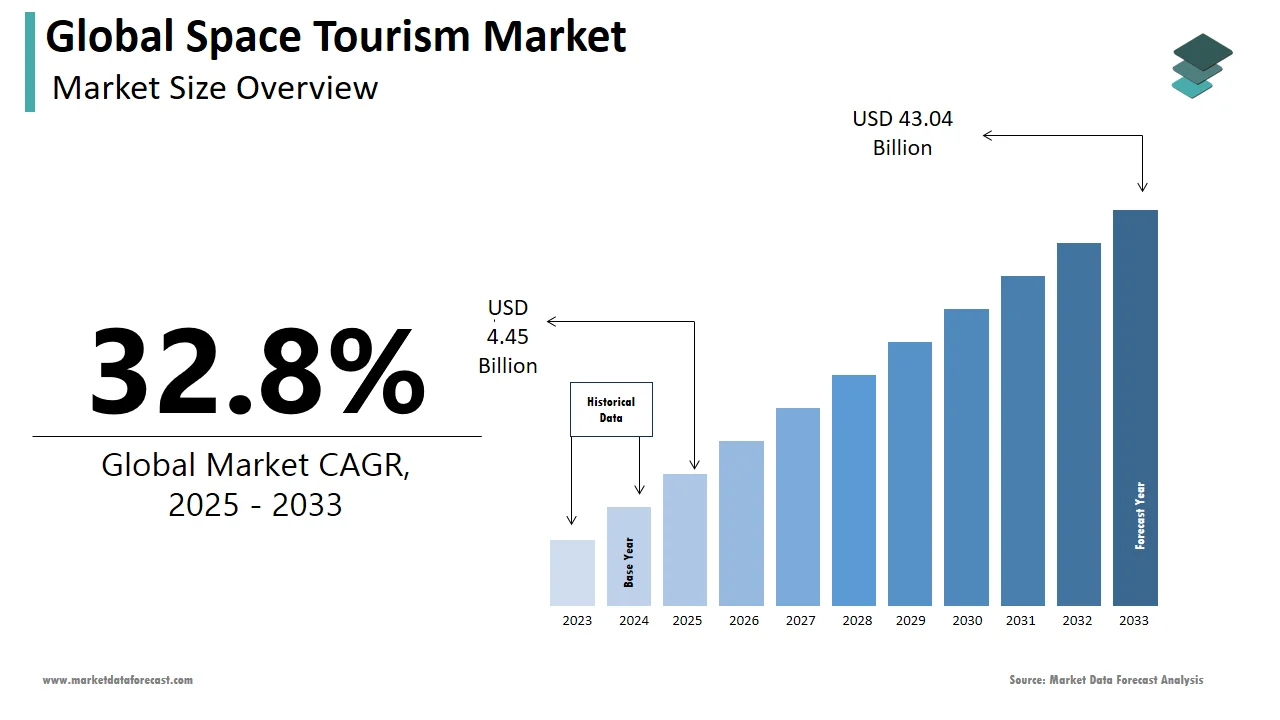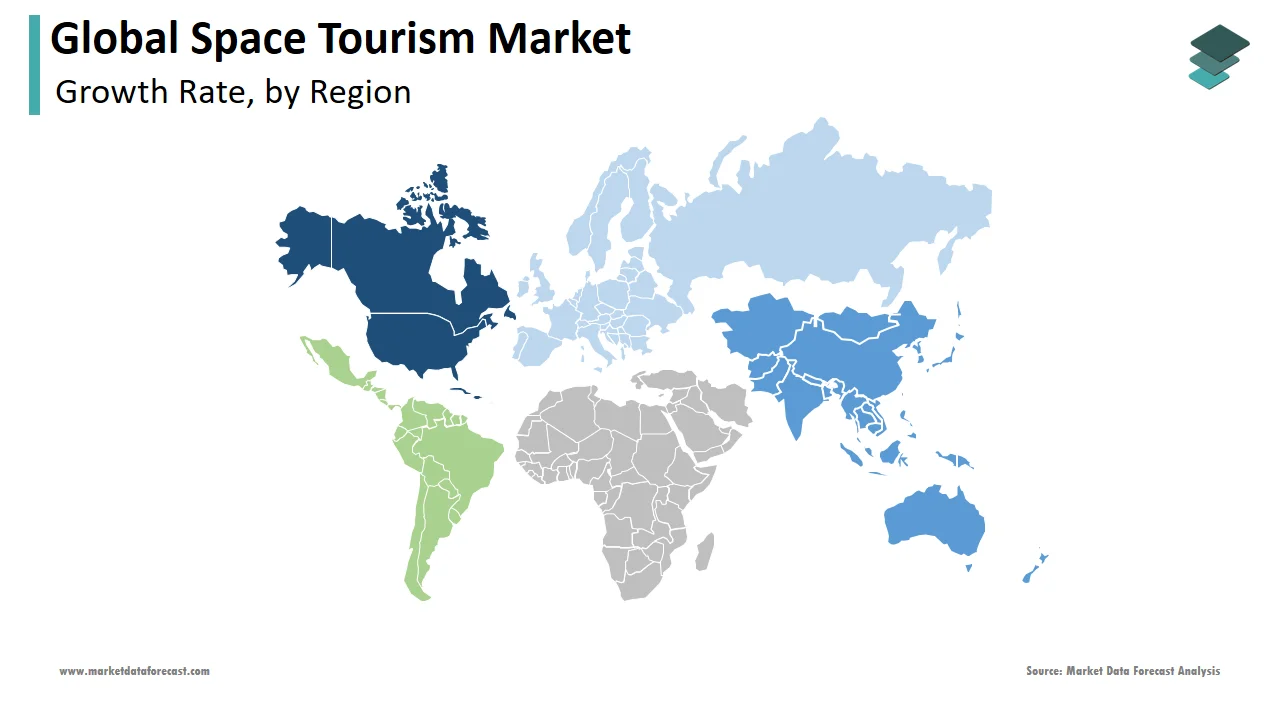Global Space Tourism Market Size, Share, Trends & Growth Forecast Report By Type (Orbital, Sub-orbital and Others), By End Use (Government, Commercial and Others), By Region (North America, Europe, Asia-Pacific, Latin America, Middle East and Africa) and Region (North America, Europe, Asia-Pacific, Latin America, Middle East and Africa), Industry Analysis From 2025 To 2033.
Global Space Tourism Market Size
The size of the global space tourism market was worth USD 3.35 billion in 2024. The global market is anticipated to grow at a CAGR of 32.8% from 2025 to 2033 and be worth USD 43.04 billion by 2033 from USD 4.45 billion in 2025.

Space tourism is a concept in which people go on a trip to outer space or near space. Space flights, suborbital flights, and space-based experiences, such as orbiting the Earth or visiting a space station, are some activities people can experience through space tourism. The companies operating in space tourism are currently offering short trips, such as traveling to space’s edge, and longer trips, such as trips to the moon and Mars. However, as of now, space tourism has not evolved much, and many opportunities to explore are not given to many. Considering the technological advancements and improvements in the capabilities of space tourism, space tourism is expected to be accessible and affordable to many during the coming years. Around the world, many private companies are putting significant efforts into developing space tourism options. A few of the market participants in the space tourism market are already offering short trips such as suborbital flights. Other market participants are developing the technology and infrastructure required to explore more complex space tourism adventures.
MARKET DRIVERS
Technological advancements are one of the major factors propelling the growth of the space tourism market.
Due to the growing adoption of the development of new technologies such as reusable rockets and spaceplanes, space tourism has become affordable and accessible. Owing to the factor above, it has become possible for the market participants of space tourism to offer services such as short trips to interested people. The growing interest from people to experience the space is anticipated to boost the space tourism market’s growth rate. Recently, interest levels from people to explore the space have been noticed; these interest levels are further anticipated to grow in the coming days, which is expected to result in market growth. In addition, the support for space tourism from the governments of developed countries in terms of investments and regulations is favoring the growth rate of the space tourism market.
The rising investments from private companies to promote space tourism ventures are predicted to favor market growth during the forecast period. The economic benefits associated with space tourism are a big plus to the market's growth. The space tourism market has the potential to generate more job opportunities in the region it operates, which further leads to economic growth. In addition, the environmental benefits associated with space tourism are expected to have a favorable impact on market growth. The usage of space tourism results in reducing environmental impact, unlike the traditional forms of tourism, by limiting the need for long-distance travel.
MARKET RESTRAINTS
High costs associated with space tourism are a significant factor hampering the market growth.
One trip to space costs hundreds of thousands to millions of dollars, which is very expensive, and more people would want to invest such a hefty amount. This high cost is expected to act as a significant restraint to the growth of the space tourism market. In addition, factors such as limited availability, safety concerns, regulatory barriers, competition from other forms of tourism, and limited infrastructure are predicted to impose an unfavourable impact on the growth rate of the space tourism market.
MARKET OPPORTUNITIES
The space tourism market is one of the potential concepts and has the potential to contribute significantly to the global economy in the coming years. The growing number of suborbital space offerings from the market participants is anticipated to offer growth opportunities. Suborbital spaceflights offer short trips through which tourists can experience the curvature of Earth from space. In the coming days, the demand for such trips is expected to increase and generate opportunities in the market. Likewise, the orbital space offering is also anticipated to generate opportunities. Furthermore, growing awareness regarding moon tourism and increasing efforts by market participants to send people to the moon are expected to offer growth possibilities in the market. For instance, SpaceX has announced its plans to send humans to the moon in the coming years.
REPORT COVERAGE
|
REPORT METRIC |
DETAILS |
|
Market Size Available |
2024 to 2033 |
|
Base Year |
2024 |
|
Forecast Period |
2025 to 2033 |
|
CAGR |
32.8% |
|
Segments Covered |
By Type, End-User, and Region. |
|
Various Analyses Covered |
Global, Regional & Country Level Analysis, Segment-Level Analysis, DROC, PESTLE Analysis, Porter’s Five Forces Analysis, Competitive Landscape, Analyst Overview of Investment Opportunities |
|
Regions Covered |
North America, Europe, APAC, Latin America, Middle East & Africa |
|
Market Leaders Profiled |
Airbus Group SE, Axiom Space, Blue Origin, Boeing, Orion Span, Space Adventures, SpaceX, Virgin Galactic, Zero2Infinity, ZERO-G, and Others. |
SEGMENTAL ANALYSIS
By Type Insights

Based on type, the sub-orbital segment accounted for the largest share of the global market in 2024 and is expected to register a healthy CAGR during the forecast period. The domination of the segment can be credited to low manufacturing costs compared to the orbital flights. The rockets can be reused for sub-orbital traveling and save enormous costs to the market participants, primarily supporting and leading to the segment’s growth.
On the other hand, the orbital segment is also anticipated to progress at a significant CAGR during the forecast period.
By End-user Insights
Based on the end-user, the commercial segment led the space tourism market in 2024 and is forecasted to showcase a promising CAGR during the forecast period. On the other hand, the government segment is predicted to showcase a promising CAGR during the forecast period.
REGIONAL ANALYSIS

North America captured a significant share of the global space tourism market in 2024. During the forecast period, the domination of the North American region is predicted to be continuing throughout the forecast period. The growth of the space tourism market in North America is primarily driven by technological advancements, increasing interest from the public regarding space travel, and the growing efforts by private companies in terms of space tourism offerings. Throughout the world, the U.S. anticipated leading the market for space tourism owing to the presence of people with high net worth and increasing investments in technological developments.
The Asia-Pacific region is projected to grow at a considerable CAGR during the forecast period. From the Asia-Pacific region, people from China are interested in exploring space tourism. They are willing to pay the high costs, which is expected to favor regional market growth. In addition, the presence of several space research organizations is expected to be a plus to the market’s growth rate.
KEY MARKET PLAYERS
Companies playing a prominent role in the global space tourism market include Airbus Group SE, Axiom Space, Blue Origin, Boeing, Orion Span, Space Adventures, SpaceX, Virgin Galactic, Zero2Infinity, ZERO-G, and Others.
RECENT MARKET HAPPENINGS
- In April 2022, NASA, Axiom, and SpaceX launched a mission to the ISS with three civilians and a former NASA astronaut. The mission was launched aboard a SpaceX Dragon spacecraft, a reusable spacecraft developed by SpaceX for transporting crew and cargo to and from the ISS.
MARKET SEGMENTATION
This research report on the global space tourism market has been segmented and sub-segmented based on type, end-user, and region.
By Type
- Orbital
- Sub-orbital
- Others
By End-user
- Government
- Commercial
- Others
By Region
- North America
- Europe
- Asia Pacific
- Latin America
- Middle East & Africa
Related Reports
Access the study in MULTIPLE FORMATS
Purchase options starting from
$ 2500
Didn’t find what you’re looking for?
TALK TO OUR ANALYST TEAM
Need something within your budget?
NO WORRIES! WE GOT YOU COVERED!
Call us on: +1 888 702 9696 (U.S Toll Free)
Write to us: sales@marketdataforecast.com